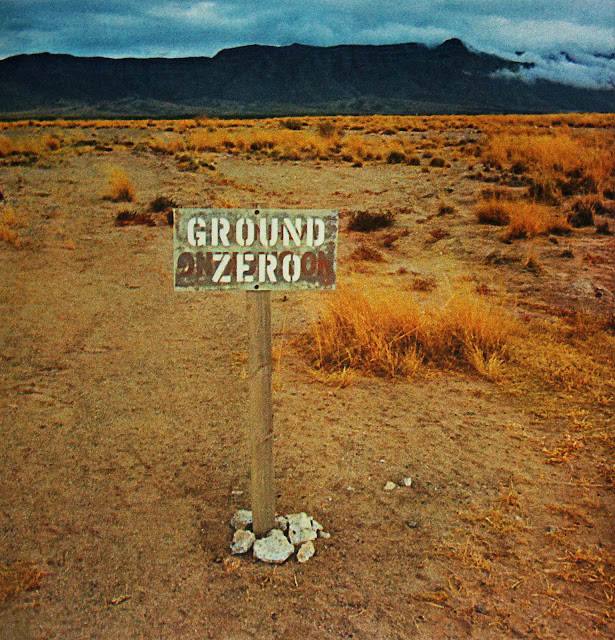When quantity passes into quality, the whole situational context is altered and a new situation emerges.
As demonstrations of new powers of genocidal violence and state terror, Auschwitz and Hiroshima were qualitative leaps of this kind. These new social facts entered history, objectively changing everything.
The scale of the Nazi genocide, meticulously planned and accounted for behind a veil of Nacht und Nebel, was only retrospectively exposed.
The vast Manhattan Project that developed the first nuclear weapons on secret presidential order was kept from the American public until the weapons were actually used; Truman triumphantly announced the atomic bombing of Hiroshima as a fait accompli.
Today, right now, we are living through another qualitative leap in the power of terror and death. But unlike these precedents, this leap has just begun and can still be stopped.
This one, if it is not stopped, will likely be the real legacy of the dirty so-called war on terror.
Without shame or apologies, Obama of the Nobel Peace Prize is presiding over a rapid escalation in the force of unmanned drones used by the US military and CIA for surveillance and assassination in Afghanistan, Iraq, Pakistan and Yemen.
Introduced by Bush II in tiny numbers, there are now an estimated 7000 drones in operation – and the number is rising fast.
As demonstrations of new powers of genocidal violence and state terror, Auschwitz and Hiroshima were qualitative leaps of this kind. These new social facts entered history, objectively changing everything.
The scale of the Nazi genocide, meticulously planned and accounted for behind a veil of Nacht und Nebel, was only retrospectively exposed.
The vast Manhattan Project that developed the first nuclear weapons on secret presidential order was kept from the American public until the weapons were actually used; Truman triumphantly announced the atomic bombing of Hiroshima as a fait accompli.
Today, right now, we are living through another qualitative leap in the power of terror and death. But unlike these precedents, this leap has just begun and can still be stopped.
This one, if it is not stopped, will likely be the real legacy of the dirty so-called war on terror.
Without shame or apologies, Obama of the Nobel Peace Prize is presiding over a rapid escalation in the force of unmanned drones used by the US military and CIA for surveillance and assassination in Afghanistan, Iraq, Pakistan and Yemen.
Introduced by Bush II in tiny numbers, there are now an estimated 7000 drones in operation – and the number is rising fast.
Bomb and missile-carrying drones such as the MQ-1 Predator (cost: $20 million per system) and MQ-9 Reaper ($53 million each) are flown by “joysticks” from air-conditioned rooms in Langley, Virginia, and Creech Air Force Base north of Las Vegas. “War porn,” the troops call it.
A small number of defense contractors, including Boeing subsidiary Insitu and General Atomics, will split the $3.5 billion allotted for drones in the 2010 budget.
To assassinate Taliban leader Baitullah Mehsud on 5 August 2009, it took the CIA sixteen drone attempts over fifteen months, killing between 207 and 321 people in the process. How many were civilians? “Disputed,” but the war wagers are sure it’s worth it.
Evidently, so are Israel, Germany and the UK, all of which fly their own fleet of combat drones. Every state that can, obviously, will follow.
Is Finnegan awake? No paranoia needed, to read the writing on this screen.
Already in development: insect-size “nano” drones, which, The New Yorker reports, “can fly after their prey like a killer bee through an open window.”
Reflect on that, in the glare of the last decade. Reflect on the leap in objective power the state gains by this. Reflect on the state of “democracy” and the rule of exception. Can anyone doubt this will alter social reality and the possibilities for a future?
For now, it takes the appearance-form of assassination power (always with “collateral” killing) – but this obviously does not exhaust potential applications. (And again: where is the outrage and debate over this policy of assassination? Is it now already normalized?)
Reality: killer robotics will expand and combine with qualitative increases in powers of surveillance (think: merger of Google with the NSA) unless massive public outcry and determined protest prevent it.
For the moment, there’s still time to organize it.
Sources:
“Drones Are Lynchpin of Obama’s War on Terror,” dossier by Spiegel Online, 12 Mar 2010.
Interview with P.W. Singer (author of Wired for War), Democracy Now, 6 Feb 2009.
Jane Mayer, “The Predator War,” The New Yorker, 26 Oct 2009
“Drones Are Lynchpin of Obama’s War on Terror,” dossier by Spiegel Online, 12 Mar 2010.
Interview with P.W. Singer (author of Wired for War), Democracy Now, 6 Feb 2009.
Jane Mayer, “The Predator War,” The New Yorker, 26 Oct 2009





















